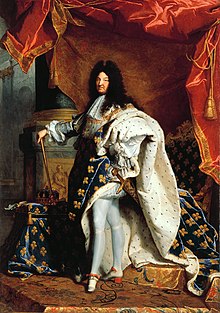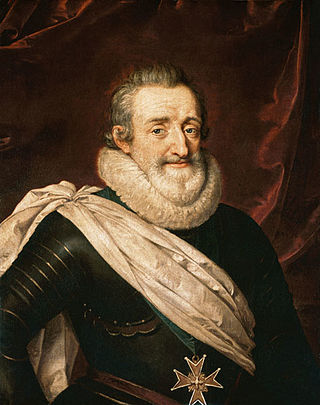
The Edict of Nantes was signed in April 1598 by King Henry IV and granted the minority Calvinist Protestants of France, also known as Huguenots, substantial rights in the nation, which was predominantly Catholic.

The Huguenots were a religious group of French Protestants who held to the Reformed (Calvinist) tradition of Protestantism. The term, which may be derived from the name of a Swiss political leader, the Genevan burgomaster Besançon Hugues (1491–1532), was in common use by the mid-16th century. Huguenot was frequently used in reference to those of the Reformed Church of France from the time of the Protestant Reformation. By contrast, the Protestant populations of eastern France, in Alsace, Moselle, and Montbéliard, were mainly Lutherans.

The French Wars of Religion were a series of civil wars between French Catholics and Protestants from 1562 to 1598. Between two and four million people died from violence, famine or disease directly caused by the conflict, and it severely damaged the power of the French monarchy. One of its most notorious episodes was the St. Bartholomew's Day massacre in 1572. The fighting ended with a compromise in 1598, when Henry of Navarre, who had converted to Catholicism in 1593, was proclaimed King Henry IV of France and issued the Edict of Nantes, which granted substantial rights and freedoms to the Huguenots. However, Catholics continued to disapprove of Protestants and of Henry, and his assassination in 1610 triggered a fresh round of Huguenot rebellions in the 1620s.
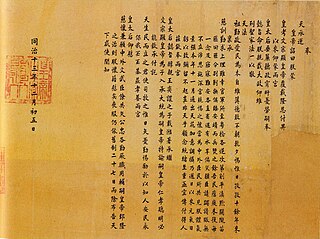
An edict is a decree or announcement of a law, often associated with monarchism, but it can be under any official authority. Synonyms include "dictum" and "pronouncement". Edict derives from the Latin edictum.

The Catholic League of France, sometimes referred to by contemporary Catholics as the Holy League, was a major participant in the French Wars of Religion. The League, founded and led by Henry I, Duke of Guise, intended the eradication of Protestantism from Catholic France, as well as the replacement of the French King Henry III, who had acquiesced to Protestant worship in the Edict of Beaulieu (1576). The League also fought against Henry of Navarre, the Protestant prince who became presumptive heir to the French throne in 1584.
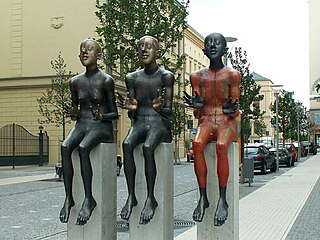
Religious toleration may signify "no more than forbearance and the permission given by the adherents of a dominant religion for other religions to exist, even though the latter are looked on with disapproval as inferior, mistaken, or harmful". Historically, most incidents and writings pertaining to toleration involve the status of minority and dissenting viewpoints in relation to a dominant state religion. However, religion is also sociological, and the practice of toleration has always had a political aspect as well.

An edict of toleration is a declaration, made by a government or ruler, and states that members of a given religion will not suffer religious persecution for engaging in their traditions' practices. Edicts may imply tacit acceptance of a state religion.

Paul Rabaut was a French pastor of the Huguenot "Church of the Desert". He was regarded by many as the leader and director of the proscribed church. He was a peacemaker and a scholar despite, due to persecution, living like a troglodyte for more than 30 years.
Camisards were Huguenots of the rugged and isolated Cévennes region and the neighbouring Vaunage in southern France. In the early 1700s, they raised a resistance against the persecutions which followed Louis XIV's Revocation of the Edict of Nantes, making Protestantism illegal. The Camisards operated throughout the mainly Protestant Cévennes and Vaunage regions including parts of the Camargue around Aigues Mortes. The revolt broke out in 1702, with the worst of the fighting continuing until 1704, then skirmishes until 1710 and a final peace by 1715. The Edict of Tolerance was not finally signed until 1787.

The Dragonnades were a French government policy instituted by King Louis XIV in 1681 to intimidate Huguenot (Protestant) families into converting to Catholicism. This involved the billeting of ill-disciplined dragoons in Protestant households with implied permission to abuse the inhabitants and destroy or steal their possessions. The soldiers employed in this role were satirized as "missionary dragoons".

During the sixteenth and seventeenth centuries, politiques were Western European statesmen who prioritized the strength of the state above all other organs of society, including religion. During the French Wars of Religion, this included moderates of both religious faiths who held that the country could only be saved by the restoration of a strong monarchy which rose above religious differences. The term politique often had a pejorative connotation of moral or religious indifference, especially after 1568 in contrast with the radical Catholic League calling for the eradication of Protestantism in France. By 1588 the politiques were seen by pious detractors as a faction more pernicious than heretics.

The Edict of Saint-Germain, also known as the Edict of January, was a landmark decree of tolerance promulgated by the regent of France, Catherine de' Medici, in January 1562. The edict provided limited tolerance to the Protestant Huguenots in the Catholic realm, though with counterweighing restrictions on their behaviour. The act represented the culmination of several years of slowly liberalising edicts which had begun with the 1560 Edict of Amboise. After two months the Paris Parlement would be compelled to register it by the rapidly deteriorating situation in the capital. The practical impact of the edict would be highly limited by the subsequent outbreak of the first French Wars of Religion but it would form the foundation for subsequent toleration edicts as the Edict of Nantes of 1598.
The Peace of Alais, also known as the Edict of Alès or the Edict of Grace, was a treaty negotiated by Cardinal Richelieu with Huguenot leaders and signed by King Louis XIII of France on 28 June 1629. It confirmed the basic principles of the Edict of Nantes but differed in that it contained additional clauses that stated that the Huguenots no longer had political rights and further demanded for them to relinquish all cities and fortresses immediately.

The Reformed Church of France was the main Protestant denomination in France with a Calvinist orientation that could be traced back directly to John Calvin. In 2013, the Church merged with the Evangelical Lutheran Church in France to form the United Protestant Church of France.
The secretary of state for protestant affairs, was the secretary of state in France during the "Ancien Régime" and Bourbon Restoration in charge of overseeing French Protestant affairs. From 1749 on, the position was combined with the position of secretary of state of the Maison du Roi.

The persecution of Huguenots under Louis XV refers to hostile activities against French Protestants between 1715 and 1774 during the reign of Louis XV.

Protestantism in France has existed in its various forms, starting with Calvinism and Lutheranism since the Protestant Reformation. John Calvin was a Frenchman, as were numerous other Protestant Reformers including William Farel, Pierre Viret and Theodore Beza, who was Calvin's successor in Geneva. Peter Waldo was a merchant from Lyon, who founded a pre-Protestant group, the Waldensians. Martin Bucer was born a German in Alsace, which historically belonged to the Holy Roman Empire, but now belongs to France.

The Huguenot rebellions, sometimes called the Rohan Wars after the Huguenot leader Henri de Rohan, were a series of rebellions of the 1620s in which French Calvinist Protestants (Huguenots), mainly located in southwestern France, revolted against royal authority. The uprising occurred a decade after the death of Henry IV who, himself originally a Huguenot before converting to Catholicism, had protected Protestants through the Edict of Nantes. His successor Louis XIII, under the regency of his Italian Catholic mother Marie de' Medici, became more intolerant of Protestantism. The Huguenots responded by establishing independent political and military structures, establishing diplomatic contacts with foreign powers, and openly revolting against central power. The Huguenot rebellions came after two decades of internal peace under Henry IV, following the intermittent French Wars of Religion of 1562–1598.
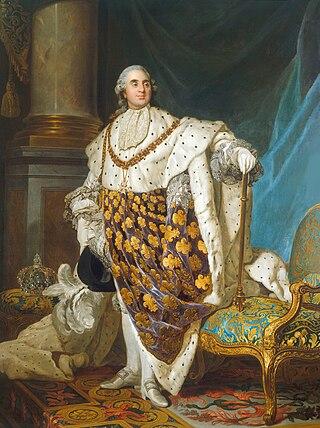
The Edict of Versailles, also known as the Edict of Tolerance, was an official act that gave non-Catholics in France the access to civil rights formerly denied to them, which included the right to contract marriages without having to convert to the Catholic faith, but it denied them political rights and public worship. The edict was signed by King Louis XVI on 7 November 1787, and registered in the Parlement of Paris during the Ancien Régime on 29 January 1788. Its successful enactment was caused by persuasive arguments by prominent French philosophers and literary personalities of the day, including Anne-Robert-Jacques Turgot; Étienne François, duc de Choiseul, Americans such as Benjamin Franklin and especially the joint work of Guillaume-Chrétien de Lamoignon de Malesherbes, minister to Louis XVI, and Jean-Paul Rabaut Saint-Étienne, spokesman for the Protestant community in France.
The French Colony of Magdeburg was a separate and independent community that existed from 1685 to 1808 in the city of Magdeburg. It co-existed, without any clear boundaries, with the citizens of the city and with the somewhat later colony of German Palatines. Its residents were Huguenot refugees, under the protection of the Elector of Brandenburg-Prussia. The colony had its own church, town hall, mayor, court and even its own home guard, and spoke French every day in all of them and on its streets.
